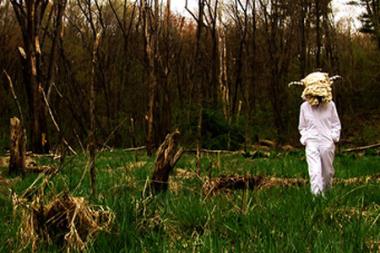Water indeed reflects heaven because my mind does—such is its own serenity—its transparency—and stillness.
—Henry David Thoreau
“I suppose I have always had a sick fascination in depicting catastrophes, and the flood of 1955 was definitely that,” says Easthampton artist Burns Maxey.
The flood, a by-product of Hurricane Diane, destroyed several Easthampton buildings in its wake. Floors were missing from the factory at One Cottage Street—the very building where Maxey now creates.
That disaster serves as one of the major driving forces behind her Project Elements Easthampton: Water, the second of four multimedia installations, featuring audio, video, and sculpture.
“Water” opens July 10th at One Cottage Street Studios, Room 1-06, with additional visual work to be on display at the Easthampton City Arts gallery at the Old Town Hall on 43 Main Street.
*
Maxey graduated from the Rhode Island School of Design before embarking on a life as a fulltime artist. She says she created some multimedia work while at RISD, but had turned her focus to painting for a time.
Her current work suggests a deep engagement in conceptually-based installation, which to Maxey means “basically anything and everything.”
Her latest opus, Project Elements Easthampton, is an ambitious undertaking that will ultimately span several years and locations and a multitude of media. It was born of a desire for freedom from the restraints of form and genre.
“I have never been a proponent of the idea of style,” she says. “And this project was a way for me to explore that idea by letting loose and not being constrained by stylistic concerns.”
Maxey says she became fascinated with the idea of place, and how layers of one’s environment—history, biology, architecture—form a community. Simultaneously she was getting more involved in her own community of Easthampton, and wanted to delve deeper into it.
“Bringing the universality of the elements—everyone is affected by earth, water, air and fire—together with the notion of the local makes the project comprehensible to both insiders and outsiders,” Maxey says. “It also gave me a framework to begin the project.”
The first installation, “Earth,” featured blown-up nighttime photos of Easthampton homes, chairs covered with living grass, and old telephones playing prerecorded phone messages submitted by residents, depicting their own personal memories of the town.
Whereas that show focused on memory and the past, “Water” hones in on dreams and the surreal. Maxey says that in researching the “Earth” piece, she encountered numerous opposing texts with conflicting dates and records, a disorienting experience that catapulted her into a world of questioning history. She was inspired to study the concept of false narrative and the idea that our minds have the ability to fully construct memories whether the actual events happened or not.
“I think dreams play a big part in this idea,” she says. “Our brains piece together nonsensical narratives to create stories that we can manage to comprehend.”
As part of the project, she asked three Easthampton women to collect their dreams, then recorded those dreams next to local waterways, capturing the field recordings and, in a sense, “returning their dreams to reality.”
Maxey says she learned a great deal about many aspects of waterways in Easthampton, and about how incidents like the one in 1955 left indelible marks on the town and its collective psyche.
Her biggest revelation and focus, however, became former town resident Albert Kiesling: painter, snow sculptor, musician, actor and “parade-float-papier-mache-sculpture-maker-extraordinaire.” Like Maxey herself, he was a town character obsessed with making art about Easthampton. Understandably, he plays an important role in the “Water” piece.
*
Maxey does not limit herself in terms of media, location or scope once she delves into a piece.
“There are no rules on the media I choose,” she says. “It is an instinctual process of selection choosing whatever medium fits the aspect of the piece. For instance, I am collaborating with the band Timecard [see Behind the Beat, page 29] in creating a musical score for the video that will be at One Cottage Street. Music made sense as a means for another auditory experience opposing the dreams. I also am working with sculpture, found furniture and even costuming.”
“Water” is a surreal combination of audio, video, and sculpture. One room is covered in various shades of blue, creating an aquatic environment replete with blue beds with bulbous mattresses “evocative of pregnancy or obesity.” Blue headphones are distributed throughout the installation for listeners to hear the dream recitations, while others play Timecard’s original musical score for an ethereal video that guides the viewer through dream sequences featuring Easthampton historical figures, waterways and surreal narratives.
Another room plays a video and audio installation incorporating clips from Patty Gambarini’s documentary, Reflections of the Lower Mill Pond, a recounting of one couple’s story of their relationship with the Lower Mill Pond during the height of Easthampton’s mill era.
In conjunction with the Cottage Street installation, the Easthampton City Arts gallery will feature video stills, objects, sculptures and collages that relate to water and the installation.
Maxey’s work has brought her—and anyone who has witnessed or become a part of it—closer to the town and the wider Valley. Like all good art, Project Elements Easthampton has become part of town’s fabric itself in the process.
And the artist still has two elements to go.
“Air, then fire,” she says. “I can’t say much more except air might have something to do with the city’s gangs of young skateboarders, Whiskerz’s bikers, and Arcadia’s wildlife sanctuary.”
All exhibits are free and open to the public and take place in One Cottage Street, Room 1-06 and the Easthampton City Arts gallery, 43 Main St. in Easthampton. For more information, visit www.projectelementseasthampton.com.



